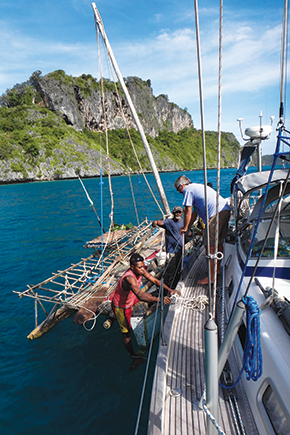Discovering the custom of building and sailing traditional canoes in Papua New Guinea (published July 2014)
We see sails. Not the tall white sails typical of modern sailboats, but low, long, dipping lug sails in an array of colors and, as it turns out, materials. They move quickly and effortlessly inside the lagoon near steep, lush Panasia Island in the Louisade Archipelago of Papua New Guinea.
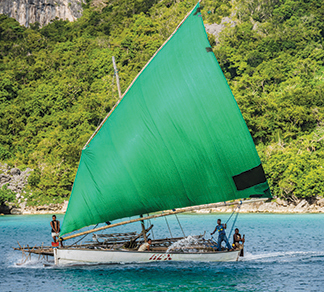
John and his family live on Panasia. He has a sailing canoe, called a “sailau” in the local Misima language. It is named JKIDS after himself and his children—John, Kanon, Immanuel, Dorothy and Sevolina. His half-brother has a much larger sailau, HEX, which is about 40 feet long and can carry 20 people. Juda keeps HEX at Brooker, an island 10 miles across the lagoon. Some days John and Kanon sail JKIDS over to Brooker and return on HEX.
Panasia and Brooker are part of the Calvados Chain, which is 120 miles southeast of the mainland. People in this area live much as their ancestors did in houses made of bush material. They eat what they grow in their gardens or catch in the sea. Sailing canoes allow people to travel long distances to interact with extended family and trading partners. This is done mostly without “kina” although cash is necessary for school fees, medical treatment and dry goods. We learn shell money is still used for things such as paying a bride price and making an offering at a traditional ceremony. John shows us a carved ceremonial axe, called an “abalaga,” which is used in the same way. Jim and I quickly become part of the trading community as people sail over from Brooker. They approach, drop their sails and paddle up to Tenaya. The crew of each boat is excited to see what the other has to offer.
PANAPOMPOM ISLAND
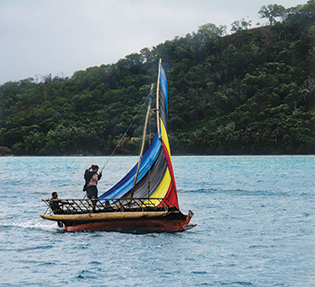
John paid one abalaga for his wife and another for his sailing canoe, which was built on Paneati. It has been the center of sailau construction in the Louisiades for over 100 years. With a paper aboard by Mark Smaalders and Jeff Kinch about the subject, we sail 30 miles north to the Deboyne Group to learn more. Shallow water keeps us from getting close to Paneati so we anchor between Nivani and Panapompom islands. There are builders on Panapompom as well.
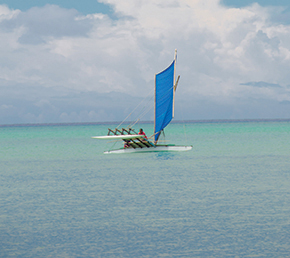
Sailaus are hand hewn wooden outrigger canoes with one mast. The keel and hull are made from “malauwi” trees that grow on Paneati. One curved tree is used for the keel. A second tree is used for the frames and straight planks of the hull. It is an ancient design. From each frame a round beam, about 1.5 inches wide, is lashed to the hull to support the outrigger that is the same length as the hull. It is fastened to the beams using crossed sticks. A two-part platform is made of slender sticks from a special wood chosen for strength and flexibility. It is tied to the crossbeams. The sticks are all the same size and carefully sanded. Knots at the ends are critical to performance and must be tied precisely. If one isn’t right, the sailor must stop at an island to adjust it. Sailaus are true double-enders with a carved and painted vertical prow at each end of the hull. The helmsman sits at the stern with one leg over the prow so his foot rests on the extending keel. He steers with a large paddle.
Sails are suspended between a yard and a boom almost the length of the mast. They are made from bamboo or another long, straight wood. Sails are made of nylon, plastic or canvas tarpaulins, rice bags, old Dacron sails from cruisers, or a combination of materials sewn together. The sail design dates to the early twentieth century when a local man working in Queensland saw an Australian pearl-lugger and copied the design.
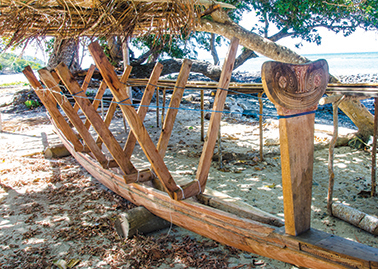
Sailing canoes can travel up to 15 knots. To change direction the boom is untied from the stern. Then the mast is raked toward the bow, the sail is swung around the mast, and the boom reattached. The helmsman takes the long steering paddle to what is now the stern. The outrigger is always to windward and acts as a balance weight. In higher winds the mast is angled towards the outrigger, in lighter winds it stands more upright. Wooden shims hold the adjustment.
One of the first people we meet at Panapompom is Joseph. He is from Brooker and is working on his beached sailau. “How long do sailaus last?” Jim asks looking at Joseph’s worn sailing canoe.
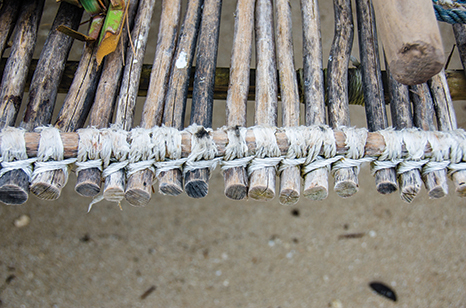
“About 20 years,” Joseph says.
“How old is this?”
“20 years.”
Joseph is brave to have sailed his leaking, separating sailau 30 miles over the Solomon Sea. He needs to repair it before he can go home. Until Jim helps him, the sailing canoe has no screws or bolts. The pieces are constructed so they interconnect, reinforcing each other. Rope made from vines helps hold other parts together. A special caulk made from the meat of a tree seals all the joints.
We are on Tenaya the day Joseph leaves. He sails close, hollers and holds something in the air. Jim’s biggest screw driver! It would certainly be valuable to the islanders but Joseph returns it before his shiny black sail, complete with vertical battens, disappears over the horizon.
Next we sail 644 miles to Kavieng, the capital of New Ireland province. This is mainly a cash-based economy where people work various jobs allowing them to buy motorized boats and pay for fuel or simply take water taxis. There are no longer sailing canoes or a local language here. The social structure is changing. Unlike in the isolated islands, they do not need the trading networks of the past. However, new friends on tiny Nusalik Island show us a four-foot long shell money necklace proving all traditions are not lost.
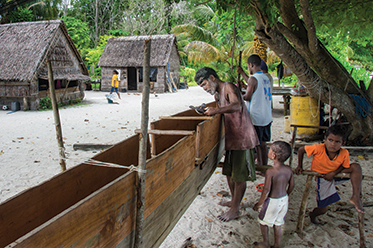
MAL ISLAND, NINIGO ATOLL
Searching for the pass through the barrier reef at Ninigo Atoll, 730 miles west of Kavieng, I see a brilliant blue canted rectangle sliding south inside the lagoon. As we creep towards the anchorage another one skims by. Sailing canoes! These look very different from those in the Louisades. After dropping the anchor we are telling stories in the cockpit with Thomas and the welcoming committee when one approaches. “That’s my brother,” Thomas says. Joseph waves as he glides by.
David Lewis put Ninigo on the map, literally, in his book, We, the Navigators. He studied the construction, sailing and navigational techniques of several areas across the Pacific including Ninigo. Lewis befriended Itilon here and sailed on his 52-foot sailing canoe. I fetch our copy to show them. Westley gets a hold of it and doesn’t put it down. The others read over his shoulder. They all know the boat in the pictures. Westley points out the island where Itilon lived and says some of his family lives here on Mal.
Thomas says he is building his own sailing canoe, called a “wa” in the local Seimat language. He is about to put the hull on the keel and invites us to watch and take photos.
“Do you make many was?” Jim asks.
“No. I have to wait for the right type of driftwood to wash up on the beach.”
“How often does that happen?”
“About every two years, sometimes longer. So I wait.”
Thomas and his family begin putting the wa together. The keel has already been shaped from wood grown on the island and hard wooden dowels have been pounded into it. The dowels poke through holes cut in foam that stretches the length of the narrow edge.
Corresponding holes have been drilled into the bottom of the hull, which rests next to the keel. The hull is made from the very hard, reddish wood that washes up on shore. “Hunahun” planks are cut from this driftwood log and then planed until smooth. Thomas uses tools from his great grandfather. There is no electricity. Thomas and Richard lift up the hull as Elizabeth makes sure the first holes are aligned before they slowly set it down. Lines drawn in pencil on both the keel and hull mark the location of the dowels. Once the hull is resting on the keel, Richard and Clement force them together with vises. When the dowels are no longer visible, the pencil marks meet. This is where Richard and Clement drill narrow holes to pound in wooden nails called “hasa”. These can last more than 10 years. The outrigger will be attached next.
At the far end of the island we meet Leopard who shows us the large wa his brother has just finished. Their father is pictured sitting on Itilon’s sailing canoe. We meet Itilon’s daughter, Robin, and her kids. They are all curious about the book so we print copies of the photos for them. Chris Omen is headmaster of the school and we promise to send him a copy for the library.
Westley is thrilled when we give him the book. He shows it to Sheddy, another of Itilon’s grandchildren. Westley says he is very happy because he wants to learn the currents, which are illustrated, so he will know where to look when someone goes missing in their canoe.
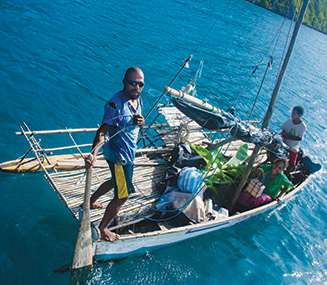
Archaeological evidence shows humans reached New Guinea 60,000 years ago and 30,000 years ago moved on to the Bismarck and Solomon Islands. About 3,000 years ago the migration east continued, reaching Vanuatu and Fiji. By 1,700 to 1,800 years ago they had reached the Cook Islands, French Polynesia and Easter Island. Many experts believe the Polynesians continued east and reached South America. While some researchers say more proof is needed, Dr. Lisa Matisoo-Smith, Dept. of Anatomy, University of Otago, NZ told us over tequila on board Tenaya in Kavieng that “There was no sign on Easter Island saying, ‘stop here, no more islands’, only the mainland!” Lisa gave us a thumb drive with several papers relating to the westward migration in the Pacific including one she co-authored, Untangling Oceanic settlement: the edge of the knowable. Also on the stick was Voyaging by canoe and computer: experiments in the settlement of the Pacific Ocean.
Geoffrey Irwin from the Dept. of Anthropology at the University of Auckland is also a cruiser. From his own experiences, he realized that wind and currents were very important to the eastward migration. Other researchers have shown that major voyages could not have occurred by drift alone and required navigational skills.
Irwin and Simon Bickler created a computer program using wind and current information, the probability of storms, and the distance different height islands could be seen. This program plotted the probable courses of sailing canoes using different strategies, their chances of finding a new island and then the possibility of a safe return. The program showed that a strategy of directed navigation and returning by latitude sailing had a reasonable chance of finding new islands and a very good chance of a safe return. Irwin and Bickler concluded that the explorers were concerned for their safety, their actions were deliberate and rational, and they did not have a mistaken view of their oceanic world as they spread swiftly across it.
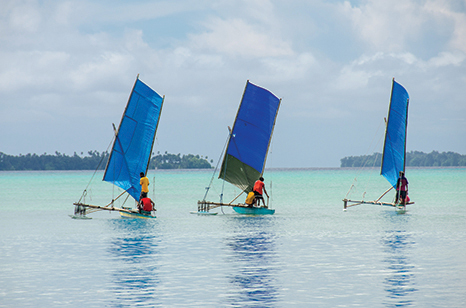
The people living in Ninigo are descendants of these early sailors and navigators. Sailing is still an integral part of their lives. Itilon’s canoe was large and had two sails. Those we saw were small and had one, but it appears they are assembled much the same way they were nearly 50 years ago and perhaps for hundreds of years before that. While we visited Westley, Sheddy and others at Piakahu village, three appeared on the horizon and sailed up to the beach. Jim took dozens of photos as they arrived and departed. Plans were to have a race that day with Tenaya being a mark, but the wind was light so it was canceled. We were happy they still went sailing and we could watch from shore. “Kemulik wanen!” Thank you very much.
I wonder how long sailing canoes will survive in these isolated island groups of Papua New Guinea now that motorized boats are available. Traditional subsistence could evolve to a cash based economy, forever changing the way of life. Skills of the sailing canoe builders might eventually be lost. But fortunately for those of us traveling the world by sailboat today, we can see them and even go for a sail in the Louisiades and Ninigo islands of Papua New Guinea.
Additional reading: The Prehistoric Exploration and Colonisation of the Pacific, Geoffrey Irwin, 1992.
Katie loves sailing off the beaten path and learning about new cultures. When most boats left Australia to sail west through Indonesia, she and her husband, Jim, headed to Papua New Guinea . They didn’t see another sailboat until they reached Palau three months later. After sailing through the Philippines and trekking in the jungles of Borneo, she finds herself in Thailand learning to cook.

















